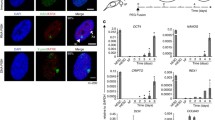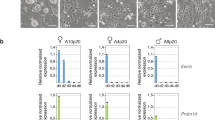Abstract
The restricted gene expression pattern of a differentiated cell can be reversed by fusion of the somatic cell with a more developmentally potent cell type, such as an embryonic stem (ES) cell. During this reprogramming process, somatic cells obtain most of the characteristics of pluripotent cells. Reactivation of an inactive X chromosome (Xi) is an important epigenetic marker confirming the pluripotent reprogramming of somatic cells. Female somatic cells contain one active X chromosome (Xa) and one Xi, and following the fusion of these cells with male ES cells, the Xi becomes activated, resulting in XaXaXaY fusion hybrid cells. To monitor Xi reactivation, transgenic female neural stem cells (fNSCs) carrying a green fluorescent protein (GFP) reporter gene expressed on the Xa (X-GFP), but not on the Xi, were used for reprogramming. XaXiGFP NSCs, whose GFP reporter was silenced, were fused with HM1 ES cells (XY) to induce pluripotent reprogramming. The XiGFP of NSCs were found to be activated on day 4 post-fusion, indicating reactivation of the Xi. Hybrid cells showed pluripotent cell-specific characteristics cells including inactivation of the NSC marker Nestin, DNA demethylation of Oct4, DNA methylation of Nestin, and reactivation of the Xi. Following differentiation of the (GFP-positive) hybrid cells through embryoid body formation, the proportion of GFP-negative cells was found to be approximately 26 %, indicating that there was random inactivation of one of the three Xas. Here, we showed that the Xi of somatic cells is reprogrammed to the Xa state and that cellular differentiation occurs randomly, i.e., regardless of the Xa or Xi state, indicating that the memory of the Xi of somatic cells has been erased and reset to the ground state (i.e., inner cell mass-like state), indicating that random X-chromosome inactivation occurs upon differentiation.




Similar content being viewed by others
References
Ying QL, Nichols J, Evans EP, Smith AG (2002) Changing potency by spontaneous fusion. Nature 416(6880):545–548. doi:10.1038/nature729
Do JT, Han DW, Gentile L, Sobek-Klocke I, Wutz A, Scholer HR (2009) Reprogramming of Xist against the pluripotent state in fusion hybrids. J Cell Sci 122(Pt 22):4122–4129
Do JT, Scholer HR (2004) Nuclei of embryonic stem cells reprogram somatic cells. Stem Cells 22(6):941–949
Tada M, Morizane A, Kimura H, Kawasaki H, Ainscough JF, Sasai Y, Nakatsuji N, Tada T (2003) Pluripotency of reprogrammed somatic genomes in embryonic stem hybrid cells. Dev Dyn 227(4):504–510
Do JT, Han DW, Scholer HR (2006) Reprogramming somatic gene activity by fusion with pluripotent cells. Stem Cell Rev 2(4):257–264
Lyon MF (1961) Gene action in the X-chromosome of the mouse (Mus musculus L.). Nature 190:372–373
Yang X, Smith SL, Tian XC, Lewin HA, Renard JP, Wakayama T (2007) Nuclear reprogramming of cloned embryos and its implications for therapeutic cloning. Nat Genet 39(3):295–302
Hajkova P, Surani MA (2004) Development. Programming the X chromosome. Science 303(5658):633–634
McBurney MW, Strutt BJ (1980) Genetic activity of X chromosomes in pluripotent female teratocarcinoma cells and their differentiated progeny. Cell 21(2):357–364
Norris DP, Patel D, Kay GF, Penny GD, Brockdorff N, Sheardown SA, Rastan S (1994) Evidence that random and imprinted Xist expression is controlled by preemptive methylation. Cell 77(1):41–51
Stewart CL, Gadi I, Bhatt H (1994) Stem cells from primordial germ cells can reenter the germ line. Dev Biol 161(2):626–628
Tchieu J, Kuoy E, Chin MH, Trinh H, Patterson M, Sherman SP, Aimiuwu O, Lindgren A, Hakimian S, Zack JA, Clark AT, Pyle AD, Lowry WE, Plath K (2010) Female human iPSCs retain an inactive X chromosome. Cell Stem Cell 7(3):329–342. doi:10.1016/j.stem.2010.06.024
Stadtfeld M, Hochedlinger K (2010) Induced pluripotency: history, mechanisms, and applications. Genes Dev 24(20):2239–2263. doi:10.1101/gad.1963910
Hanna J, Cheng AW, Saha K, Kim J, Lengner CJ, Soldner F, Cassady JP, Muffat J, Carey BW, Jaenisch R (2010) Human embryonic stem cells with biological and epigenetic characteristics similar to those of mouse ESCs. Proc Natl Acad Sci USA 107(20):9222–9227
Lengner CJ, Gimelbrant AA, Erwin JA, Cheng AW, Guenther MG, Welstead GG, Alagappan R, Frampton GM, Xu P, Muffat J, Santagata S, Powers D, Barrett CB, Young RA, Lee JT, Jaenisch R, Mitalipova M (2010) Derivation of pre-X inactivation human embryonic stem cells under physiological oxygen concentrations. Cell 141(5):872–883
Eggan K, Akutsu H, Hochedlinger K, Rideout W 3rd, Yanagimachi R, Jaenisch R (2000) X-Chromosome inactivation in cloned mouse embryos. Science 290(5496):1578–1581
Nolen LD, Gao S, Han Z, Mann MR, Gie Chung Y, Otte AP, Bartolomei MS, Latham KE (2005) X chromosome reactivation and regulation in cloned embryos. Dev Biol 279(2):525–540
Senda S, Wakayama T, Yamazaki Y, Ohgane J, Hattori N, Tanaka S, Yanagimachi R, Shiota K (2004) Skewed X-inactivation in cloned mice. Biochem Biophys Res Commun 321(1):38–44
Do JT, Han DW, Gentile L, Sobek-Klocke I, Stehling M, Scholer HR (2008) Enhanced reprogramming of Xist by induced upregulation of Tsix and Dnmt3a. Stem Cells 26(11):2821–2831. doi:10.1634/stemcells.2008-0482
Nesterova TB, Mermoud JE, Hilton K, Pehrson J, Surani MA, McLaren A, Brockdorff N (2002) Xist expression and macroH2A1.2 localisation in mouse primordial and pluripotent embryonic germ cells. Differentiation 69(4–5):216–225
Tada T, Obata Y, Tada M, Goto Y, Nakatsuji N, Tan S, Kono T, Takagi N (2000) Imprint switching for non-random X-chromosome inactivation during mouse oocyte growth. Development 127(14):3101–3105
Takagi N, Yoshida MA, Sugawara O, Sasaki M (1983) Reversal of X-inactivation in female mouse somatic cells hybridized with murine teratocarcinoma stem cells in vitro. Cell 34(3):1053–1062
Do JT, Han DW, Gentile L, Sobek-Klocke I, Stehling M, Lee HT, Scholer HR (2007) Erasure of cellular memory by fusion with pluripotent cells. Stem Cells 25:1013–1020
Hadjantonakis AK, Gertsenstein M, Ikawa M, Okabe M, Nagy A (1998) Generating green fluorescent mice by germline transmission of green fluorescent ES cells. Mech Dev 76(1–2):79–90
Lyon MF (1999) X-chromosome inactivation. Curr Biol 9(7):R235–R237
Monkhorst K, Jonkers I, Rentmeester E, Grosveld F, Gribnau J (2008) X inactivation counting and choice is a stochastic process: evidence for involvement of an X-linked activator. Cell 132(3):410–421. doi:10.1016/j.cell.2007.12.036
Ji H, Ehrlich LI, Seita J, Murakami P, Doi A, Lindau P, Lee H, Aryee MJ, Irizarry RA, Kim K, Rossi DJ, Inlay MA, Serwold T, Karsunky H, Ho L, Daley GQ, Weissman IL, Feinberg AP (2010) Comprehensive methylome map of lineage commitment from haematopoietic progenitors. Nature 467(7313):338–342
Kim K, Doi A, Wen B, Ng K, Zhao R, Cahan P, Kim J, Aryee MJ, Ji H, Ehrlich LI, Yabuuchi A, Takeuchi A, Cunniff KC, Hongguang H, McKinney-Freeman S, Naveiras O, Yoon TJ, Irizarry RA, Jung N, Seita J, Hanna J, Murakami P, Jaenisch R, Weissleder R, Orkin SH, Weissman IL, Feinberg AP, Daley GQ (2010) Epigenetic memory in induced pluripotent stem cells. Nature 467(7313):285–290
Marchetto MC, Yeo GW, Kainohana O, Marsala M, Gage FH, Muotri AR (2009) Transcriptional signature and memory retention of human-induced pluripotent stem cells. PLoS ONE 4(9):e7076
Kim K, Doi A, Wen B, Ng K, Zhao R, Cahan P, Kim J, Aryee MJ, Ji H, Ehrlich LI, Yabuuchi A, Takeuchi A, Cunniff KC, Hongguang H, McKinney-Freeman S, Naveiras O, Yoon TJ, Irizarry RA, Jung N, Seita J, Hanna J, Murakami P, Jaenisch R, Weissleder R, Orkin SH, Weissman IL, Feinberg AP, Daley GQ (2010) Epigenetic memory in induced pluripotent stem cells. Nature 467(7313):285–290. doi:10.1038/nature09342
Sullivan GJ, Bai Y, Fletcher J, Wilmut I (2010) Induced pluripotent stem cells: epigenetic memories and practical implications. Mol Hum Reprod 16(12):880–885. doi:10.1093/molehr/gaq091
Polo JM, Liu S, Figueroa ME, Kulalert W, Eminli S, Tan KY, Apostolou E, Stadtfeld M, Li Y, Shioda T, Natesan S, Wagers AJ, Melnick A, Evans T, Hochedlinger K (2010) Cell type of origin influences the molecular and functional properties of mouse induced pluripotent stem cells. Nat Biotechnol 28(8):848–855. doi:10.1038/nbt.1667
Maherali N, Sridharan R, Xie W, Utikal J, Eminli S, Arnold K, Stadtfeld M, Yachechko R, Tchieu J, Jaenisch R, Plath K, Hochedlinger K (2007) Directly reprogrammed fibroblasts show global epigenetic remodeling and widespread tissue contribution. Cell Stem Cell 1(1):55–70. doi:10.1016/j.stem.2007.05.014
Sugimoto M, Abe K (2007) X chromosome reactivation initiates in nascent primordial germ cells in mice. PLoS Genet 3(7):e116. doi:10.1371/journal.pgen.0030116
Navarro P, Chambers I, Karwacki-Neisius V, Chureau C, Morey C, Rougeulle C, Avner P (2008) Molecular coupling of Xist regulation and pluripotency. Science 321(5896):1693–1695. doi:10.1126/science.1160952
Dhara SK, Benvenisty N (2004) Gene trap as a tool for genome annotation and analysis of X chromosome inactivation in human embryonic stem cells. Nucleic Acids Res 32(13):3995–4002
Hall LL, Byron M, Butler J, Becker KA, Nelson A, Amit M, Itskovitz-Eldor J, Stein J, Stein G, Ware C, Lawrence JB (2008) X-inactivation reveals epigenetic anomalies in most hESC but identifies sublines that initiate as expected. J Cell Physiol 216(2):445–452
Hoffman LM, Hall L, Batten JL, Young H, Pardasani D, Baetge EE, Lawrence J, Carpenter MK (2005) X-inactivation status varies in human embryonic stem cell lines. Stem Cells 23(10):1468–1478
Silva J, Barrandon O, Nichols J, Kawaguchi J, Theunissen TW, Smith A (2008) Promotion of reprogramming to ground state pluripotency by signal inhibition. PLoS Biol 6(10):e253
Guo G, Yang J, Nichols J, Hall JS, Eyres I, Mansfield W, Smith A (2009) Klf4 reverts developmentally programmed restriction of ground state pluripotency. Development 136(7):1063–1069
Nichols J, Smith A (2009) Naive and primed pluripotent states. Cell Stem Cell 4(6):487–492
Ware CB, Wang L, Mecham BH, Shen L, Nelson AM, Bar M, Lamba DA, Dauphin DS, Buckingham B, Askari B, Lim R, Tewari M, Gartler SM, Issa JP, Pavlidis P, Duan Z, Blau CA (2009) Histone deacetylase inhibition elicits an evolutionarily conserved self-renewal program in embryonic stem cells. Cell Stem Cell 4(4):359–369. doi:10.1016/j.stem.2009.03.001
Ambrosi DJ, Tanasijevic B, Kaur A, Obergfell C, O’Neill R, Krueger W, Rasmussen TP (2007) Genome-wide reprogramming in hybrids of somatic cells and embryonic stem cells. Stem Cells 25:1104–1113
Acknowledgments
This work was supported by the National Research Foundation of Korea (NRF) funded by the Ministry of Education, Science and Technology (Grant 20110019489) and by the Next Generation Bio-Green 21 Program funded by the Rural Development Administration (Grant PJ008009).
Author information
Authors and Affiliations
Corresponding author
Additional information
Hyun Woo Choi, Jong Soo Kim and Hyo Jin Jang equally contributed to this manuscript.
Electronic supplementary material
Below is the link to the electronic supplementary material.
Rights and permissions
About this article
Cite this article
Choi, H.W., Kim, J.S., Jang, H.J. et al. Reestablishment of the inactive X chromosome to the ground state through cell fusion-induced reprogramming. Cell. Mol. Life Sci. 69, 4067–4077 (2012). https://doi.org/10.1007/s00018-012-1139-6
Received:
Revised:
Accepted:
Published:
Issue Date:
DOI: https://doi.org/10.1007/s00018-012-1139-6




